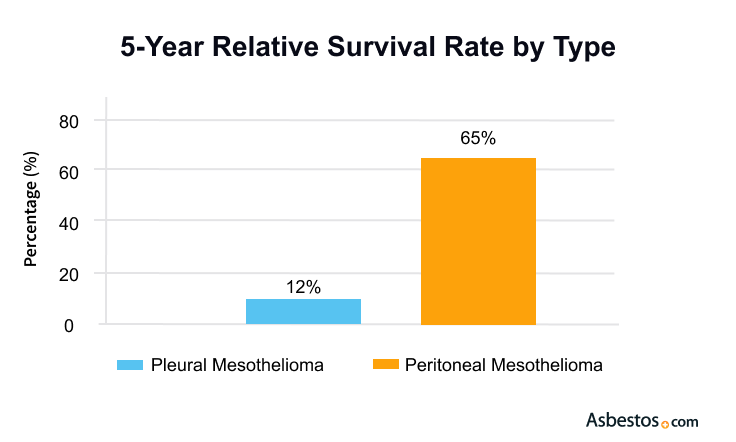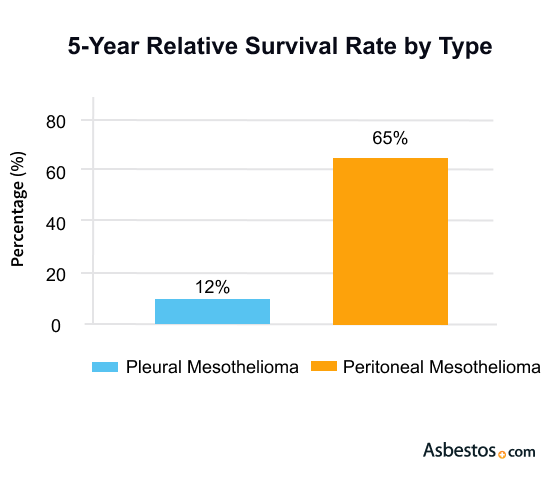Pleural mesothelioma survivor Kevin Sinyard far surpassed the average mesothelioma survival rate. He was initially told he only had 6 months to live before undergoing extrapleural pneumonectomy surgery. He then underwent aggressive chemotherapy and radiation regimens. Kevin told us, “I’m proof that you can survive and still live a really good life.”
Mesothelioma Survival Rate
Mesothelioma survival rates depend on treatment and cancer stage. The average survival rate for mesothelioma is about 15 months after diagnosis with treatment. The five-year survival rate for pleural mesothelioma is approximately 12%. Some patients have lived for more than 10 years after treatment.
What Is the Mesothelioma Survival Rate?
Mesothelioma survival rates are the percentage of cancer patients alive 1 year or more after diagnosis. The latest 5-year survival rate for pleural mesothelioma is 12%, based on the most recent data from the Surveillance, Epidemiology, and End Results database. In other words, patients with pleural mesothelioma are about 12% more likely than those who don’t have pleural mesothelioma to live at least 5 years after their diagnosis. For peritoneal mesothelioma, SEER shows it’s much higher at 65%.
Statistics may not apply to any one individual. Some mesothelioma patients may live for a long time after treatment. For example, peritoneal mesothelioma survivor Tammy Frank has been alive 25 years beyond her life expectancy.
- The 5-year survival rate for peritoneal mesothelioma is 65%.
- The 5-year survival rate for pleural mesothelioma is 12%.
- SEER’s data from 2000-2020 show a rise in survival rates. The 1-year, 3-year and 5-year relative survival rates are trending up.
- The average survival after a patient’s diagnosis is 18 months, with a 1-year survival rate of 73% for pleural and 92% for peritoneal.
Survival rates for mesothelioma depend on a few factors. They include the cancer’s location and stage. They also depend on the patient’s health and treatments. The top ways to treat mesothelioma are surgery, chemo, radiation and immunotherapy.
The National Cancer Institute issues data on mesothelioma survival every few years. It does so through the SEER program. The data shows a steady trend of improved survival rates over the past 2 decades.
How Do Mesothelioma Survival Rates Affect You?
Your doctor will use mesothelioma survival rate data to assess your prognosis. This data is based on thousands of cases. It averages patient survival times. It can’t predict your outcome. But, it can show you what happened to similar patients.
“What frustrates me most, and I hear this often with new patients, is, ‘I just saw my doctor today, and they said I have a year to 16 months to live.’ That is not the case,” says RN and Patient Advocate Karen Selby. “You’re an individual. This is your story.”
Survival rate data is one piece of the puzzle. A doctor uses it to find the best mesothelioma treatment for you. For example, stats show younger patients survive at higher rates. They can qualify for aggressive treatments. If you’re a younger patient, your doctor may recommend surgery, for example.
There have been people who survived way beyond what the statistics say. I plan on being one of those. I have a lot of people counting on me being around. I’m not going to disappoint them.
What Factors Affect Your Mesothelioma Survival Rates?
Survival rates for mesothelioma vary depending on factors such as the cancer’s stage, location and treatment type. Age, gender and overall health also matter. These affect how long a person will live after a mesothelioma diagnosis.
- Age: Younger patients have a higher survival rate of mesothelioma.
- Cell type: Epithelial mesothelioma has a higher survival rate.
- Disease stage: As the cancer spreads, survival rates decline.
- Gender: Women tend to have a higher survival rate of mesothelioma than men.
- Genetics: Some genes can help mesothelioma patients live longer.
- Location: The survival rate is higher for peritoneal mesothelioma.
- Overall health: Patients in better health tend to live longer with mesothelioma.
- Type of treatment: Aggressive treatments can lead to better outcomes.
Women and younger patients tend to live longer. Those with peritoneal tumors, early-stage disease or epithelioid cells often live a longer life. So do those who pursue multimodal therapy.
Tumor Location
Peritoneal mesothelioma has a much better survival rate than pleural disease. About 65% of all peritoneal mesothelioma patients survive for 5 years or more.
This is 5 times the 5-year survival rate compared to pleural patients. Eligible patients with asbestos-related cancer in the peritoneum live between 31 months and 103 months with HIPEC surgery.
Gender
Women diagnosed with mesothelioma tend to have longer survival rates compared to men. This trend holds true regardless of age, mesothelioma stage, race or treatment type. For instance, the 5-year relative survival rate for pleural mesothelioma is 21.42% for women, compared to 9.3% for men.
Researchers are exploring why women with mesothelioma live longer than men. Women are also more likely to be diagnosed with peritoneal mesothelioma. This type of mesothelioma has better survival than pleural tumors. This skews survival rates to favor women, who live longer on average.

Understand your diagnosis, top doctors and ways to afford care.
Get Your Free GuideAge
Younger people with mesothelioma have better survival outcomes compared to older patients. Approximately 75% of mesothelioma patients diagnosed before age 50 survive at least one year after diagnosis. But only 44% of patients aged 65 or older with mesothelioma live for one year. Age is a significant factor in mesothelioma survival rates, as younger individuals often respond better to treatment.
Younger patients are usually healthier. So, they can use more aggressive and effective therapies. They’re also less likely to have other, lasting health issues at the same time. Older patients are more likely to have other lung diseases, diabetes or a history of cancers.
Cancer Stage
The stage of mesothelioma at diagnosis is a strong predictor of your overall survival. The SEER Program groups cancer survival rates into: Localized, regional and distant stages. This grouping distills the 4 pleural mesothelioma stages into 3. “Localized” represents stage 1. “Regional” roughly represents stages 2 and 3. “Distant” represents stage 4.
Patients in the early stages have better survival rates if treated quickly. They’re more likely to qualify for surgery and other aggressive treatments. More aggressive therapies are linked to better outcomes.
| 1-Year | 3-Year | 5-Year | |
|---|---|---|---|
| Stage 1-2 | 61.1% | 30.7% | 20.6% |
| Stage 3 | 56.7% | 26.0% | 13.8% |
| Stage 4 | 42.9% | 15.7% | 9.2% |
Mesothelioma Cell Type
The types of cells that make up tumors impact patient survival. Mesothelioma has 3 cell types: Epithelioid, sarcomatoid and biphasic.
Biphasic tumors have epithelioid and sarcomatoid features. A higher count of epithelial cells means a better prognosis for mesothelioma patients. If a patient’s cancer is mostly sarcomatoid cells, their mesothelioma life expectancy is lower.
Overall Health and Genetics
Mesothelioma patients with a history of smoking, heavy alcohol use or poor diet tend to have lower survival rates. Coexisting conditions, such as heart disease and diabetes, can affect your survival as well.
- Alcohol and Tobacco: Heavy alcohol use and smoking can lower mesothelioma survival.
- Coexisting Medical Conditions: Chronic issues, such as heart or lung disease and diabetes, reduce mesothelioma survival.
- Exercise: Regular exercise is vital for good health.
- Genetics: Black patients with mesothelioma survive at a higher rate than white patients.
- Nutrition: Drinking enough water can help. A high-calorie, nutritious diet can help as well.
Good nutrition and exercise can help you live longer. A healthy diet and regular exercise help patients respond better to cancer treatment.
Your genes and family history also play a role. More than 90% of mesothelioma cases occur in white men. But Black patients have a nearly 5% better 5-year survival rate.

Join our upcoming webinar where two leading mesothelioma specialists explain how they tailor treatment plans to each patient’s needs.
Sign up nowMesothelioma Survival Rates by Type
Mesothelioma survival rates depend on the type and stage of the cancer. Pleural mesothelioma is the most common type. It’s more aggressive and harder to detect early. Most patients live 12 to 21 months after diagnosis.
Peritoneal mesothelioma affects the abdomen. It responds better to treatment. For example, surgery and heated chemo or HIPEC greatly boosts survival in patients.
Pericardial mesothelioma is a rare cancer around the heart. It’s usually diagnosed late. The average life expectancy is 3 to 10 months. Treatment is mainly for symptom relief. Testicular mesothelioma is the rarest type, affecting the area around the testes. Patients often live 20 months to 2 years, depending on the stage and treatment.
| Type of Mesothelioma | Average Life Expectancy | 5-Year Survival Rate |
|---|---|---|
| Pleural Mesothelioma | 12-21 months | 12% |
| Peritoneal Mesothelioma | 3-5 years (with HIPEC) | 65% |
| Pericardial Mesothelioma | 3-10 months | Less than 1% |
| Testicular Mesothelioma | 20 months-2 years | Data is limited |
Comparing 5-Year Survival Rates
The 5-year survival rate is 12% for pleural mesothelioma. For peritoneal mesothelioma, it’s 65%.
Many peritoneal patients live more than 5 years if treated early. We also work with pleural patients who have lived more than 5 years from the time of their diagnosis. Michael Cole, for example, is a 9-year pleural mesothelioma survivor.


How To Improve Your Mesothelioma Survival
Many factors can improve the survival rate for mesothelioma patients. An early diagnosis and access to new treatments, such as immunotherapy and targeted therapies, play a critical role in extending survival. Long-term survivors say that coordinated care and clinical trials helped them. Some survivors also emphasize the importance of lifestyle changes. For example, a healthier diet helped them after diagnosis.
Don’t assume your prognosis is based only on mesothelioma survival stats. A 5-year survival rate doesn’t show how mesothelioma cancer symptoms may affect your quality of life. Each patient reacts differently to treatment. Chemo, surgery and immunotherapy can help people live longer.
- Early Detection: Improves prognosis.
- Clinical Trials: Offer access to cutting-edge treatments.
- Healthy Lifestyle: Supports the body during treatment.
A study of pleural patients found that, on average, those who got surgery, chemo and radiation lived for 21.7 months. Those who declined treatment survived for 10.2 months.
Another study in the Journal of Cancer Research and Clinical Oncology found patients with better nutrition lived 18 months, on average. Those with poor nutrition lived for 11 months.
Surviving Mesothelioma
Your overall health and treatment for mesothelioma may help you live longer than the survival rates suggest. The 5-year survival rates don’t consider the most recent advances in medicine.
Statistics may be a source of comfort for some people and confusing or frightening for others. However, survival rates only consider people diagnosed in the past. Those diagnosed today may have more therapy choices and a better chance of survival. New treatments are helping people live longer.

Because we had been living live the year type of thing. You know?
But after recovery, we’re more aware of things that are happening to us. And we do things more programmed, you know, like, we want to do this. I mean, like, now it’s not only that we have a bucket list. Now it’s that we have a we’re going to do this list. That yes, there is a tomorrow, but we’re planning for it.
That tomorrow is very important. It’s sacred, you know, that I like to use I’d like to use that word that it’s sacred. Your life is sacred and that we’re more mindful of it and that we understand it more. That it could be taken away from you and, through no fault of your own. And we’re just more mindful of of that sacred life that we have.
“We had been living a ‘live the year’ type of thing. But after recovery, now it’s not only that we have a bucket list. We have a ‘we’re going to do this’ list,” Brunilda Villareal, the wife of a mesothelioma survivor, told us. “Tomorrow is very important. It’s sacred.”
- Recent trials of one type of mesothelioma vaccine saw 55% 2-year and 21% 5-year survival for pleural patients. The average 2-year survival is usually 18% and 5-year is 12%.
- Trials of new approaches aiming to improve life expectancy are ongoing. And many factors affect an individual’s personal life expectancy including how early someone is diagnosed.
“New therapies, like immunotherapy and vaccines, are changing how we treat cancer. “Hopefully, these trends will lead to longer survival and a cure.”
Common Questions About Mesothelioma Survival Rates
- What is the average mesothelioma survival rate?
-
Based on tumor location alone, survival rates vary. The average 5-year survival rate for pleural mesothelioma is about 12%. For peritoneal mesothelioma, it’s 65%. Cell type, mesothelioma stage, age, sex and overall health also influence the survival rate.
- Is mesothelioma always fatal?
-
Malignant mesothelioma is an aggressive and fatal disease, however, some patients have survived more than 10 years after their diagnosis. While there is no cure for this cancer, there have been advances in care. Most mesothelioma patients only survive approximately 12 months after diagnosis, but treatment may extend mesothelioma survival.
- What is the difference between a mesothelioma survival rate and mortality rate?
-
Survival rate is the percent of cancer patients who live a certain number of years after diagnosis. For example, 20.7% of mesothelioma patients live for 3 years or more. The mesothelioma mortality rate is the number of deaths in certain areas and groups of people. For example, in 2021, there were 0.7 mesothelioma deaths per 100,000 people in the U.S.
- How does the survival rate of mesothelioma compare to the lung cancer survival rate?
-
The 5-year survival rate for mesothelioma patients is about 12%. The 5-year survival rate for lung cancer patients is about 26.6%.
- How do other health conditions affect mesothelioma survival rates?
-
People with health conditions are at risk of treatment complications. Heart disease, diabetes and high blood pressure can be risk factors. Some patients may not qualify for surgery if they have these conditions. Surgery is the most effective therapy to extend survival.






